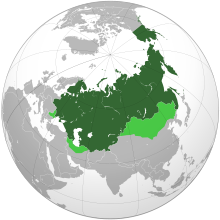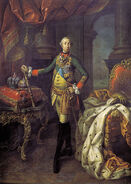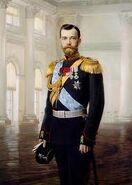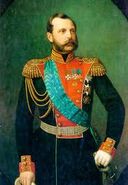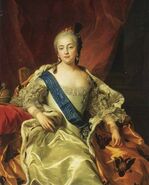No edit summary Tags: Visual edit apiedit |
No edit summary Tags: Visual edit apiedit |
||
| (8 intermediate revisions by the same user not shown) | |||
| Line 12: | Line 12: | ||
|info-fc = GOLD |
|info-fc = GOLD |
||
|id = |
|id = |
||
| − | |info = The Government of the Russian Empire is led by |
+ | |info = The Government of the Russian Empire is led by Emperor Vladmir I}}</p> |
{{Infobox |
{{Infobox |
||
| − | |Box title = |
+ | |Box title = Russian Empire |
|image = File:russian_imperial_flag1.gif |
|image = File:russian_imperial_flag1.gif |
||
|caption = The Russian Imperial Flag |
|caption = The Russian Imperial Flag |
||
| Line 27: | Line 27: | ||
|Row 4 info = Absolute Monarchy |
|Row 4 info = Absolute Monarchy |
||
|Row 5 title = Emperor |
|Row 5 title = Emperor |
||
| − | |Row 5 info = Vladimir I |
+ | |Row 5 info = Vladimir I |
|Row 6 title = Heir to Throne |
|Row 6 title = Heir to Throne |
||
|Row 6 info = Ivan VI |
|Row 6 info = Ivan VI |
||
| Line 41: | Line 41: | ||
'''The Empire of Russia'' '''''<nowiki/>''(Императорский России; Imperatorskiy Rossii)''',''''' is a country in northern Eurasia. With the largest empire in the world, Russia is a respected world power with a unique culture and society. |
'''The Empire of Russia'' '''''<nowiki/>''(Императорский России; Imperatorskiy Rossii)''',''''' is a country in northern Eurasia. With the largest empire in the world, Russia is a respected world power with a unique culture and society. |
||
| − | The Tsardom of Russia's leadership is a constitutional monarchy, in which the emperor (tsar) exercises supreme power. Emperor '''[[User:Jeremiah Garland|Vladimir I]]''' is the current monarch of Russia. Occasionally, his reign is accompanied by a regent, namely Grand Duke '''[[User:Nults McKagan|Richard of Moscow]]'''. The Prime Minister of Russia, who has limited power beneath the Tsars, and heads the Emperor's Council of Ministers, is '''Kazimir Yaromirovich Kovlovsky'''. |
+ | The Tsardom of Russia's leadership is a constitutional monarchy, in which the emperor (tsar) exercises supreme power. Emperor '''[[User:Jeremiah Garland|Vladimir I]]''' is the current monarch of Russia. Occasionally, his reign is accompanied by a regent, namely Grand Duke '''[[User:Nults McKagan|Richard of Moscow]]'''. The Prime Minister of Russia, who has limited power beneath the Tsars, and heads the Emperor's Council of Ministers, is '''[[User:Kazimir Kovlovsky|Kazimir Yaromirovich Kovlovsky]]'''. |
In 1721, Tsar Peter I of the Tsardom of Russia officially converted the tsardom to the Empire of Russia following the Treaty of Nystad. Although, officially, all monarchs of Russia are to hold the title "Emperor of Russia", the ceremonial and traditional title of "tsar" is still commonly, yet incorrectly, used. |
In 1721, Tsar Peter I of the Tsardom of Russia officially converted the tsardom to the Empire of Russia following the Treaty of Nystad. Although, officially, all monarchs of Russia are to hold the title "Emperor of Russia", the ceremonial and traditional title of "tsar" is still commonly, yet incorrectly, used. |
||
| Line 249: | Line 249: | ||
*'''[[User:Cadet96|King Ferdinand VI]]''' |
*'''[[User:Cadet96|King Ferdinand VI]]''' |
||
| |
| |
||
| − | *''' |
+ | *'''Allied''' |
*'''Friendly''' |
*'''Friendly''' |
||
|- |
|- |
||
| Line 324: | Line 324: | ||
==Governmental and Royalty Officials== |
==Governmental and Royalty Officials== |
||
===Russian Royal Family=== |
===Russian Royal Family=== |
||
| − | *''His Imperial Majesty The Emperor and Autocrat of all the Russias Vladimir Petrovich Romanov |
+ | *''His Imperial Majesty The Emperor and Autocrat of all the Russias Vladimir Petrovich Romanov'' (Владимир Петрович Романов) |
| − | *''His Imperial Majesty The Crowned Prince of all the Russias Ivan Vladimirovich Romanov |
+ | *''His Imperial Majesty The Crowned Prince of all the Russias Ivan Vladimirovich Romanov'' (Иван Владимирович Романов) |
| + | *''Her Imperial Majesty Princess Regina Vladimirovna Romanova'' (Регина Владимировна Романовна) |
||
=== Regency === |
=== Regency === |
||
| − | * ''His Majesty Grand Duke Richard Barfolomeyevich of Moscow'' |
+ | * ''His Majesty Grand Duke Richard Barfolomeyevich of Moscow'' (Ричард Барфоломеевич) |
===Russian Imperial Court=== |
===Russian Imperial Court=== |
||
| − | * |
+ | *Prime Minister —'' Kazamir Yaromirovich Kovlovsky'' (Казамир Яромирович Ковловский) |
| + | *Minister of War— ''Lavrentiy Genrivich Chiltonev'' (Лаврентий Генривич Чилтонев) |
||
| − | *Procurator General (Speaker of the House) — ''Lev Semyonivich Rogazhin'' |
||
| − | *Minister of War— ''Sergei Ibrahimovich Gergiev'' |
||
*Minister of Infrastructure—N/A |
*Minister of Infrastructure—N/A |
||
| − | *Minister of Finance— '' |
+ | *Minister of Finance— ''Finn Aleksandrovich Khamm'' (Финн Александрович Хамм) |
| + | *Minister of Navy—''Julius Jakstas Aiksnoras'' (Юлиус Яакстас Айкснорас) |
||
| − | *Minister of Navy—N/A |
||
| − | *Minister of the Courts — |
+ | *Minister of the Courts — ''Gannibal Lvovich Buschkuyet'' (Ганнибал Лвович Бущкует) |
==History== |
==History== |
||
===Previous Tsars=== |
===Previous Tsars=== |
||
| Line 375: | Line 375: | ||
By the close of the 17th century, Russia had emerged as a world power, yet seemed isolated from the rest of the western world. In 1682, Tsar Peter I "the Great" came to power in the Tsardom of Russia. Under his rule, Russia would not only accomplish significant victories against Sweden and Poland-Lithuania in the Great Northern War, but would also be launched into a "cultural revolution". Under Peter the Great, art, literature, architecture, science, and music flourished in Russia, awarding them membership into the western world. Perhaps Peter I's greatest achievement, though, was the construction of St. Petersburg on the Baltic Sea in 1723. The city, the site of a captured Swedish fort, not only became the new Russian capital, but also a world mecca of culture, earning it the nickname the "Venice of the East". |
By the close of the 17th century, Russia had emerged as a world power, yet seemed isolated from the rest of the western world. In 1682, Tsar Peter I "the Great" came to power in the Tsardom of Russia. Under his rule, Russia would not only accomplish significant victories against Sweden and Poland-Lithuania in the Great Northern War, but would also be launched into a "cultural revolution". Under Peter the Great, art, literature, architecture, science, and music flourished in Russia, awarding them membership into the western world. Perhaps Peter I's greatest achievement, though, was the construction of St. Petersburg on the Baltic Sea in 1723. The city, the site of a captured Swedish fort, not only became the new Russian capital, but also a world mecca of culture, earning it the nickname the "Venice of the East". |
||
| + | ==== Present Day ==== |
||
| − | In 1745, after the resignation of Tsar Andrei I, Tsar Mikhail II, the true heir to the throne, took over. Only days after his rule, though, he handed power over to a close friend and native Briton Vladimir I. However, after a breakdown by Tsar Vladimir I due to high pressure by numerous nations, he handed the throne down to his son, Tsar Ivan VIII. Later Tsar VIII invited former Tsar Venyamin I to hold the throne with him. Russia is now a diarchy. |
||
| + | Following the sudden death of Emperor Venyamin I, a brief period of civil war engulfed the nation. However, Venyamin's confidant and fellow Englishman Andrew Mallace soon rose victorious and reigned briefly as Andrei I. Upon his return to Britain, the throne passed first to his cousin Mikhail Volkov, and then to Venyamin's brother (and son of Peter the Great) Vladimir Romanov. The two reigned dually as Mikhail II and Vladimir I, but after the former's sudden abdication, Vladimir reigned alone for two years. Then, in 1746, the emperor's son and heir to the throne, Ivan Vladimirovich Romanov, staged an illegal invasion of Prussia and later rebelled against his father. Vladimir relinquished power to his son and fled to Sweden, where he was offered asylum. Subsequently, Russia was invaded by a coalition of Prussian, Austrian, and British forces, and Ivan VI was forced to abdicate in favour of the distantly-related Qing Emperor of China Gabriel I. Following his mysterious assassination later that year, Vladimir I at last returned to Russia and regained his throne, restoring peace and order. 1746 is thus called the "Year of Three Emperors". Vladimir I has continued to reign alone ever since, though his son Ivan has been pardoned for his rebellion and has resumed his title of crown prince. |
||
| − | |||
| − | |||
| − | ==Government== |
||
| − | Like nations such as Great Britain, France, and Spain, Russia is a combined-government type of a kingdom (monarchy) and an empire. In 1721, Peter the Great had converted the Tsardom of Russia into the Empire of Russia. However, rather than take on the title of "Emperor", all Russian rulers since have kept the title of "Tsar". |
||
| − | |||
| − | Russia's kingdomship is officially an enlightened diarchy, in which almost all power is limited to the two tsars. However, a portion of the power belongs to the Russian Imperial Court, a parliamentarian group of politicians who are responsible for setting laws, proposing new ideas (to be approved by the tsars), and handling foreign relations. In addition, each member of the Imperial Court specializes in a certain field (e.g., the Minister of Finance, the Minister of Religion) and act as advisers to the tsars. |
||
| − | |||
==Economy== |
==Economy== |
||
| Line 389: | Line 383: | ||
Russian trade is mercantile-based. The primary trade company (owned by the Tsars and the Imperial Court) is the Russian Trade Federation, operating out of the imperial capital St. Petersburg. Other notable Russian trade cities include Arkhangelsk on the White Sea, Odessa on the Black Sea, Baku on the Caspian Sea, Magadan in the Sea of Okhotsk, and Vladivostok on the Pacific Ocean. |
Russian trade is mercantile-based. The primary trade company (owned by the Tsars and the Imperial Court) is the Russian Trade Federation, operating out of the imperial capital St. Petersburg. Other notable Russian trade cities include Arkhangelsk on the White Sea, Odessa on the Black Sea, Baku on the Caspian Sea, Magadan in the Sea of Okhotsk, and Vladivostok on the Pacific Ocean. |
||
| ⚫ | |||
| − | Though the Russian economy is ran by either of the Russian Tsars (in this case, Vladimir I), both the Minister of Finance and the Minister of Trade and Commerce, both members of the Russian Imperial Court, have a strong influence in the economy. All new taxes are to be proposed by the Russian Imperial Court, and submitted for approval to the Tsars. The Imperial Court is headed by the prime minister, who is the head of the legislative body and is immediately given all autocratic authority should both tsars be absent, ill, or killed. The successor of the prime minister is the Speaker of the Court, who also acts as the voice of the Imperial Court. |
||
| − | |||
| ⚫ | |||
==Gallery== |
==Gallery== |
||
Latest revision as of 02:48, 27 June 2017
The Empire of Russia (Императорский России; Imperatorskiy Rossii), is a country in northern Eurasia. With the largest empire in the world, Russia is a respected world power with a unique culture and society.
The Tsardom of Russia's leadership is a constitutional monarchy, in which the emperor (tsar) exercises supreme power. Emperor Vladimir I is the current monarch of Russia. Occasionally, his reign is accompanied by a regent, namely Grand Duke Richard of Moscow. The Prime Minister of Russia, who has limited power beneath the Tsars, and heads the Emperor's Council of Ministers, is Kazimir Yaromirovich Kovlovsky.
In 1721, Tsar Peter I of the Tsardom of Russia officially converted the tsardom to the Empire of Russia following the Treaty of Nystad. Although, officially, all monarchs of Russia are to hold the title "Emperor of Russia", the ceremonial and traditional title of "tsar" is still commonly, yet incorrectly, used.
Tsar Peter I's son, Vladimir, soon arose to the throne in 1744. Following his temporary abdication the following year the throne passed to his eldest son, the tsetsarevich Ivan VI, who in turn was forced to abdicate in favour of Emperor Gavriel I, a distant cousin. Following Gavriel's assassination in early 1746, Vladimir I once again reclaimed the throne and continues to rule as emperor.
Geography
Physical
The Russian Empire straddles both the Asian and European continents, split roughly 75% and 25% in each continent, respectively. Stretching from the eastern extent of the Baltic Sea in the west to the Northern Pacific Ocean in the Far East, and from the Caspian Sea in the south to the Arctic Ocean in the north, Russia covers more than one-eighth of world's land area.
At 23,700,000 square kilometres (9,150,000 square miles), the Russian Empire is the largest empire in the world. As such, it encompasses a wide range of ecosystems and biomes. While the western extremities of the empire are not uncharacteristic of the rest of Europe, the central and eastern Siberian steppes consist of both vast prairies and heavily wooded forests. The Ural Mountains, stretching down the spine of Russia's European-Asian division, and the Caucasus Mountains, occupying the area between the Black and Caspian Seas, make up the tallest mountains in the world. The Western Kazakh-Ciscaucasusian area, as well as the Ukrainian steppes (both within the southwest of the empire), are considered the empire's "breadbasket" for their arable land fed by the Volga, Don, and Dnieper Rivers; these areas account for more than half of the empire's agricultural production. The extreme north of Siberia, the Siberian islands, and the North American colony of Alaska, mostly dominated by tundra and permafrost, are by and large uninhabitable.
Political
The Russian Empire is subdivided into eighteen gubernii (губернии), or governorates. Each is operated under the jurisdiction of a royally-appointed governor, as well as a local council of boyars. The eighteen governorates are listed below:
| Governorate (Russian) | Governorate (English) | Capital |
|---|---|---|
| Архангелогородская | Arkhangelsk (Arkhangelogorodskaya) | Arkhangelsk |
| Астраханская | Astrakhan (Astrakhanskaya) | Astrakhan |
| Азовская | Azov (Azovskaya) | Voronezh |
| Выборгская | Vyborg (Viyborgskaya) | Kexholm |
| Белору́ссиская | Belorussia (Belorussiskaya) | Minsk |
| Иркутская | Irkutsk (Irkutskaya) | Irkutsk |
| Каза́нская | Kazan (Kazanskaya) | Kazan |
| Киевская | Kiev (Kievskaya) | Kiev |
| Курляндиская | Courland (Kurlandiskaya) | Reval |
| Московская | Moscow (Moskovskaya) | Moscow |
| Новоросси́йская | Novorossiya (Novorossiyskaya) | Yekaterinoslav |
| Нижегородская | Nizhniy Novgorod (Nizhegorodskaya) | Nizhniy Novgorod |
| Рижская | Riga (Rizhskaya) | Riga |
| Санкт-Петербу́ргская | Saint Petersburg (Sankt-Peterburgskaya) | Saint Petersburg |
| Смоле́нская | Smolensk (Smolenskaya) | Smolensk |
| Тифлисская | Tiflis (Tiflisskaya) | Tiflis |
| Тобольская | Tobolsk (Tobolskaya) | Tobolsk |
| Ярославская | Yaroslavl (Yaroslavskaya) | Yaroslavl |
In addition to the eighteen imperial governorates, the Russian Empire also lays claim to three additional provinces, all of which are noncontiguous with the empire: the Grand Duchy of Serbia, a Balkan state inherited in 1744 by the Romanov crown (capital Belgrade); the island of Cyprus, purchased from the Ottoman Empire and host to Russia's first Mediterranean fleet (capital Limassol); and the Alaskan-Yukon territories of North America, mostly trapping and whaling colonies first established in 1743 (capital: Novoarkhangelsk).
Government
The Russian Empire is officially an absolute monarchy with divine rule by the emperor, though, since the 1744 – 1748 reforms fulfilled by Emperor Vladimir, there has been a great deal of additional power and influence granted to local councils and nobles (Boyari), the Imperial Senate (Duma), and the Emperor's Council of Ministers. Acting in the spirit of pre-Petrine tradition, the emperor in 1747 granted split local authority between the regional boyars and the imperially-appointed governors.
State Duma
The State Duma (Госудаственная Дума; Gosudastvennaya Duma), also commonly referred to as the Imperial Senate (Имперский Сенат; Imperskiy Senat) is the foremost governing legislative body within the empire. It is a unicameral body currently composed of 36 senators (сенаторы; senator'y), two from each governorate. The senators are elected by local councils composed of emancipated serfs, and are approved by regional land-owning nobles. The senate is headed by an elected procurator general (генеральный прокурор; general'nyy prokuror), who serves as a liaison between the senate and the emperor. The current Procurator General is Lev Simyonivich Rogazhin.
The State Duma was conceived as the successor to the mediaeval legislative system known as the Boyar Duma, by Peter the Great, first convening under his authority in 1712. Since then there has been a healthy split between the emperor and the senate, as the latter has enjoyed a relatively substantial amount of authority, particularly during the reign of the current emperor. Even still, all actions completed and laws passed by the State Duma are, legally speaking, only advisory in nature, as all final decisions rest solely with the emperor.
The State Duma convenes annually (or, rarely, upon request by the emperor) in the Tauride Palace, St Petersburg.
Foreign Relations
| Flag: | Country: | Leader(s): | Relation: |
|---|---|---|---|
| Austria |
| ||
 |
Brethren Court |
| |
| Denmark |
| ||
| France |
| ||
| Genoa |
| ||
| Great Britain & Ireland |
| ||
| Morocco |
| ||
| Netherlands |
| ||
| Poland-Lithuania |
| ||
| Portugal |
| ||
| Sardinia |
| ||
| Spain |
| ||
| Switzerland |
|
The Russian Empire
Map of the Russian Empire
Major Russian Protectorates
Europe
- Serbia
- Moldavia
- Bessarabia
- Kosovo
- Cyprus
- Courland
- Semigalia
- Livonia
- Karelia
- Vyborg
- Novgorod
- Yaroslavl
- Smolensk
- Belorussia
- Ukraine
- Saratov
- Muscovy
- Kazan
Asia / Middle East
- Palestine
- Kyrgyzstan
- Tajikistan
- Uzbekistan
- Turkmenistan
- Mongolia
- Sakhalin
- Heilongjiang
Americas
- Alaska
- Yukon
- Nunavit
Territorial History
The following acquisitions all occurred under Emperor Vladimir I
- April 22, 1745: Russia invades and briefly occupies Prussia, before granting independence
- June 3, 1745: Russia invades and annexes Mongolia
- June 20, 1745: Russia purchases and annexes Siam
- June 30, 1745: Russia trades Armenian and Circassian land to Ottoman Empire for Cyprus
- July 27, 1745: Russia purchases and annexes the free Balkan state of Montenegro
- September 20 - October 10, 1745: A series of expeditions and Russian claims in the Siberian islands
- October 21, 1745: Tatar states of Kyrgyz and Tajik conquered and annexed
- November 15, 1745: Russia purchases and annexes the state of Serbia from the Ottoman Empire
- November 16, 1745: A deal among Russia, Ottoman Empire, and Poland-Lithuania in which the latter is granted independence, and Russia gains Palestine from the Ottoman Empire
The following acquisitions all occurred under Emperor Ivan VIII
- Februrary 2., 1746: Great Britain declares war on Russia
- Februrary 3, 1746: Great Britain invades Russia; later pulls out troops and returns independence to Russia
- February 15, 1746: Negotiations are held with leader of Spain, Pearson Wright; no progress made
- February 15, 1746: Spain invades Russia; Russia declares complete isolation from Spain, exiling leader Pearson Wright into Siberia
The following acquisitions all occurred under Emperor Gabriel I
- February 19, 1746: Tensions settle, the Qing Dynasty and the Russian Empire are officially one and under Emperor Gabriel I
The following acquisitions occurred under Emperor Vladimir I
- June 18, 1746: Following Emperor Gabriel's abdication, Vladimir I once again resumes the title of emperor
- The Qing Dynasty of China is returned to Emperor Sheng, following his abdication from Russia
Governmental and Royalty Officials
Russian Royal Family
- His Imperial Majesty The Emperor and Autocrat of all the Russias Vladimir Petrovich Romanov (Владимир Петрович Романов)
- His Imperial Majesty The Crowned Prince of all the Russias Ivan Vladimirovich Romanov (Иван Владимирович Романов)
- Her Imperial Majesty Princess Regina Vladimirovna Romanova (Регина Владимировна Романовна)
Regency
- His Majesty Grand Duke Richard Barfolomeyevich of Moscow (Ричард Барфоломеевич)
Russian Imperial Court
- Prime Minister — Kazamir Yaromirovich Kovlovsky (Казамир Яромирович Ковловский)
- Minister of War— Lavrentiy Genrivich Chiltonev (Лаврентий Генривич Чилтонев)
- Minister of Infrastructure—N/A
- Minister of Finance— Finn Aleksandrovich Khamm (Финн Александрович Хамм)
- Minister of Navy—Julius Jakstas Aiksnoras (Юлиус Яакстас Айкснорас)
- Minister of the Courts — Gannibal Lvovich Buschkuyet (Ганнибал Лвович Бущкует)
History
Previous Tsars
- Ivan IV (1547 - 1584); House of Rurik
- Fyodor I (1584 - 1598); House of Rurik
- Boris I (1598 - 1605); House of Godunov
- Fyodor II (1605); House of Godunov
- Dmitri II (1605 - 1606); House of Godunov
- Vasili IV (1606 - 1610); House of Rurik
- Mikhail I (1613 - 1645); House of Romanov
- Alexei I (1645 - 1676); House of Romanov
- Fyodor III (1676 - 1682); House of Romanov
- Ivan V (1682 - 1696); House of Romanov
- Peter I (1692 - 1725); House of Romanov
- Venyamin I (1725 - 1735); House of Romanov
- Andrei I (1735 - 1744); House of Volkov
- Vladimir I (1744 - 1746); House of Romanov
- Mikhail II (1744 - 1745); House of Volkov
- Ivan VI (1746 - 1746); House of Romanov
- Gabriel I (1746 - 1746); House of Volkov
- Vladimir I (1746 - ); House of Romanov
Russian History
Early Slavic Inhabitant and the Kievan Rus
Russia's history dates back to the 9th century A.D., when Slavic traders from north-eastern Europe known as Varangians gained access to the Russian mainland via the Baltic Sea. Upon further exploration into the land, the Slavs established trading cities throughout, most notably Novgorod. Upon venturing further south into the Black Sea and Caspian Sea regions, the Varangians established more cities, including Kiev. Eventually, these cities prospered over time, and adapted their own governments. These governments acted as independent states, called a "Rus". In 882, the Kievan Rus was founded, and the first line of grand dukes entered the Kievan Golden Age. Within the next centuries, more city-states would emerge, including the Grand Duchy of the Moscovy Rus, the Kazan Rus, and the Novgorod Rus.
Mongol Conquest
In the late 12th century, land in the east, mostly inhabited by the Islamic Tatar tribes, fell under command of the Golden Horde, the portion of the Mongol Empire led by Temujin "Genghis" Khan. As the Mongol Empire expanded, the Golden Horde's influence, under different leaders, eventually crossed the Ural Mountains (acting as a boundary between Europe and Asia) and gained a hold on the governing city-states in the west. By the 1300s, nearly all of Russia had fallen into Mongolian-Tatar control.
Ivan the Terrible
During the 15th century, the Russian city-states lay in harsh turmoil. In 1547, however, Tsar Ivan IV (the "Terrible") led a revolt on the oppressive Mongols, and eventually freed western Russia from their rule. The same year, Ivan IV united all the freed Russian city-states, and declared himself first Tsar (Caesar) of "all the Russias". During his long reign (1547-1584) Ivan IV nearly doubled the already expanding Russian Tsardom, established a strong central government (including the a parliamentarian figure, the Russian Imperial Court), and established the Russian capital in the Moscovy Rus, now called Moscow.
The Romanov Dynasty
However, Russia's progress soon declined due to a line of weak rulers, and continuing wars with Poland-Lithuania, Sweden, the Crimean Khanate (a final incarnation of the Golden Horde), the Byzantine Empire, Persia, and the Ottoman Empire respectively. However, by the mid 1600s, Tsar Mikhail I came to power in Russia, and began a lasting dynasty known as the Romanov rule. Under the Romanov leaders, Russia conquered foes such as the Ottoman Empire and Persia, increased its size further, and improved the military with the addition of the Cossacks, noble yet zealous warriors hailing from the Ukrainian steppes. During this time, Russia also gained control of most of Ukraine (in addition to Kiev), after the Russo-Polish War.
Peter the Great
By the close of the 17th century, Russia had emerged as a world power, yet seemed isolated from the rest of the western world. In 1682, Tsar Peter I "the Great" came to power in the Tsardom of Russia. Under his rule, Russia would not only accomplish significant victories against Sweden and Poland-Lithuania in the Great Northern War, but would also be launched into a "cultural revolution". Under Peter the Great, art, literature, architecture, science, and music flourished in Russia, awarding them membership into the western world. Perhaps Peter I's greatest achievement, though, was the construction of St. Petersburg on the Baltic Sea in 1723. The city, the site of a captured Swedish fort, not only became the new Russian capital, but also a world mecca of culture, earning it the nickname the "Venice of the East".
Present Day
Following the sudden death of Emperor Venyamin I, a brief period of civil war engulfed the nation. However, Venyamin's confidant and fellow Englishman Andrew Mallace soon rose victorious and reigned briefly as Andrei I. Upon his return to Britain, the throne passed first to his cousin Mikhail Volkov, and then to Venyamin's brother (and son of Peter the Great) Vladimir Romanov. The two reigned dually as Mikhail II and Vladimir I, but after the former's sudden abdication, Vladimir reigned alone for two years. Then, in 1746, the emperor's son and heir to the throne, Ivan Vladimirovich Romanov, staged an illegal invasion of Prussia and later rebelled against his father. Vladimir relinquished power to his son and fled to Sweden, where he was offered asylum. Subsequently, Russia was invaded by a coalition of Prussian, Austrian, and British forces, and Ivan VI was forced to abdicate in favour of the distantly-related Qing Emperor of China Gabriel I. Following his mysterious assassination later that year, Vladimir I at last returned to Russia and regained his throne, restoring peace and order. 1746 is thus called the "Year of Three Emperors". Vladimir I has continued to reign alone ever since, though his son Ivan has been pardoned for his rebellion and has resumed his title of crown prince.
Economy
The Russian economy is a free-market one, like all other European competitors. However, due to recent philosophies and ideologies, Russia has begun experimenting with a socialist-based economy.
Russian trade is mercantile-based. The primary trade company (owned by the Tsars and the Imperial Court) is the Russian Trade Federation, operating out of the imperial capital St. Petersburg. Other notable Russian trade cities include Arkhangelsk on the White Sea, Odessa on the Black Sea, Baku on the Caspian Sea, Magadan in the Sea of Okhotsk, and Vladivostok on the Pacific Ocean.
The current Russian currency is the Ruble (also spelled Rouble). The current Russian average network income and growth revenue (as of 1750) is estimated at 5.2 billion Rubles (112 million British Schillings), making Russia the second richest nation in the world, only behind Great Britain.














